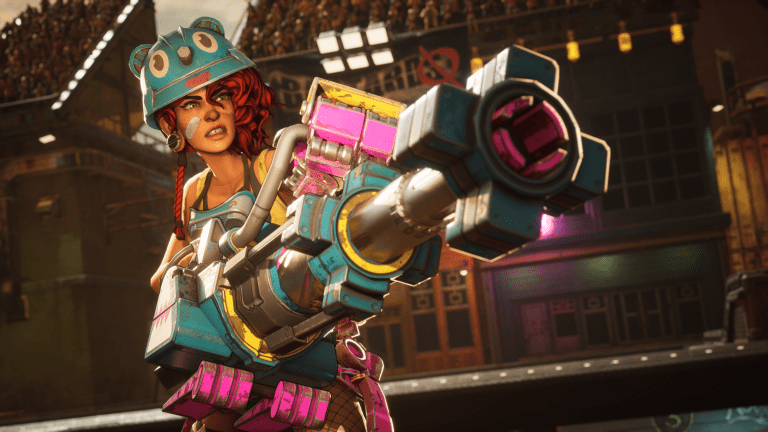Bleeding Edge Review: Not an Overwatch Clone but Not an Innovator Either
Ninja Theory's new online multiplayer game, Bleeding Edge, will surprise Hellblade fans -- for better or worse.

Let’s get this out of the way: Bleeding Edge does just enough to set itself apart from Overwatch. However, there are many design flaws that hold it back from being the next big thing in the online hero shooter genre.
Like Overwatch, Bleeding Edge lets you choose from 12 different characters filling one of three main role — damage, support, or tank — in four-on-four objective-based combat. With characters like the cyber witch Mave, who uses traps and stealth to fulfill objectives, and Cass, a part-woman, part cyborg chicken, there are a few enjoyable character designs that should fit almost any play style. My personal favorite is Gizmo, a spunky one-armed Australian who focuses on crowd control and is armed with a minigun and turrets.
Each of these characters has a set of attacks that either emphasizes melee or gun combat, as well as extra abilities that can heal, spawn turrets, or throw projectiles. But despite this variety, none of the combat carries much heft. Whether you’re shooting, slicing, or supporting, the actual gameplay doesn’t do much to stand out from dozens of other third-person titles that have come before.
Teamwork is a must in Bleeding Edge, as there are only two game modes: Objective Control and Power Collection (essentially a variation of a traditional Domination mode), both of which require players to work together to accomplish a goal. And if you don’t coordinate with your teammates, you’re going to have a bad time. If you find yourself with a weaker support character standing up against one of the hard-hitting tanks, you’re almost certainly done for.
Therein lies the basic problem with Bleeding Edge’s design. When everything is working as it’s supposed to, and your team is cooperating to take or defend a control point, it can be a pretty fun game. But when there are multiple control points active, and several power cells scattered all over the map in Power Collection, it seems like Bleeding Edge is mistakenly encouraging solo play even though going off on your own will likely mean a swift death.
Release Date: March 24, 2020
Platform: Xbox One (reviewed), PC
Developer: Ninja Theory
Publisher: Xbox Game Studios
Genre: Online Brawler/Shooter
Compounding the problem, there are only four maps at launch. They’re not bad, but they all follow the same basic asymmetric design style. At least the addition of hazards, like trains, electrified force fields, and random bombardments from above add some variety and strategy.
The online multiplayer was stable when I played after release. I had no problems finding and connecting to games, though I did regularly experience some mild lag. But there’s no search function for games. You can’t even choose between Objective Control and Power Collection.
Overall, it’s hard to shake a serious late 2000s retro vibe while playing Bleeding Edge. While hardly the worst looking game on the Xbox One, the graphics are unmistakably dated. There’s not even 4K support on the Xbox One X. And I haven’t heard this much dubstep in a game since The Office was still putting out new episodes.
So many other little issues, like being kicked back to the main menu after every match and limited game modes and maps, make Bleeding Edge feel more like a lost Xbox Live Arcade game than a 2020 release. And I haven’t even mentioned Bleeding Edge’s biggest problem: the in-game economy.
Completing matches and leveling up characters earn you credits and mod parts. Credits can be used to purchase new skins and hoverboards (another somewhat cool but not terribly important part of the game). Mod parts unlock new mods that can be used to upgrade your abilities with new perks like slightly higher damage or shorter cooldowns, or you can break them down for more mod parts.
The in-game economy is par for the course in online shooters and does help extend replay value, but the process of gaining credits and mod parts is excruciatingly slow. You could play 10 matches (which have no time limit) to purchase a single hoverboard for one character and still not have enough for a new mod part. With dozens of unlockables for each character, that adds up to a grind of hundreds of hours that few players are going to be interested in undertaking.
As a passion project from a small team, Bleeding Edge is an interesting diversion that’s fun for a few hours, but it lacks the hook of similar titles that keep players coming back for months after release. Ninja Theory has promised post-launch support, with a new trash-talking dolphin mech character promised in the next few weeks, but without some major overhauls to the gameplay and in-game economy, I doubt many players will be sticking around to see how the game improves. As it stands now, Bleeding Edge just isn’t very enjoyable after the brief honeymoon phase.
